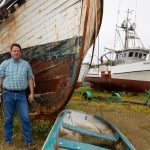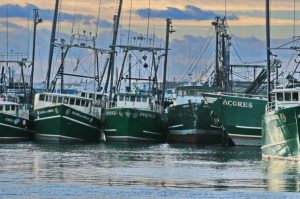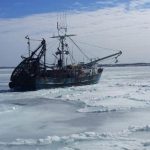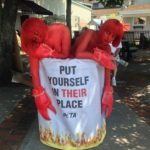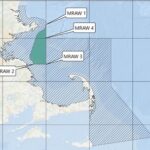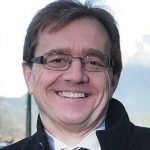Tag Archives: Northern shrimp
Moratorium on fishing Maine shrimp to continue through 2025
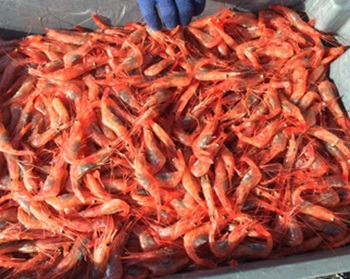 The Atlantic States Marine Fisheries Commission’s Northern Shrimp Section is maintaining the current moratorium on northern shrimp fishing through the 2025 fishing year. That makes 11 years of no commercial shrimp fishing in Maine. That action followed the 2024 Stock Assessment Update, “which indicates the northern shrimp stock has been at low levels of biomass for over the past decade despite the fishery being under a moratorium since 2014,” said the Atlantic States Marine Fisheries Commission in a Dec. 13 news release. The Update found no improvement in stock status and 2023 summer survey indices of abundance, biomass, and recruitment were the lowest in the 1984-2023 time-series. more, >>CLICK TO READ<< 07:32
The Atlantic States Marine Fisheries Commission’s Northern Shrimp Section is maintaining the current moratorium on northern shrimp fishing through the 2025 fishing year. That makes 11 years of no commercial shrimp fishing in Maine. That action followed the 2024 Stock Assessment Update, “which indicates the northern shrimp stock has been at low levels of biomass for over the past decade despite the fishery being under a moratorium since 2014,” said the Atlantic States Marine Fisheries Commission in a Dec. 13 news release. The Update found no improvement in stock status and 2023 summer survey indices of abundance, biomass, and recruitment were the lowest in the 1984-2023 time-series. more, >>CLICK TO READ<< 07:32
Opinion: Policymakers in search of sound science need to listen to fishery by Jerry Leeman
 Fishermen are gravely concerned that regulators are stealing our futures with baseless cuts to landing quotas. Rep. Jared Golden is taking positive steps to fix this problem. It often happens that government regulators, who lack deep knowledge of what it takes to catch fish in the Gulf of Maine, reach conclusions about the state of our fish stocks that do not match what fishermen are seeing and what we know from being on the water every day. The obvious objection whenever we raise this concern is that “anecdote is not the plural of data.” The doubters ask: Why would an individual fisherman know more than a government agency with a dataset? That’s a fair question. more, >>CLICK TO READ<< 08:02
Fishermen are gravely concerned that regulators are stealing our futures with baseless cuts to landing quotas. Rep. Jared Golden is taking positive steps to fix this problem. It often happens that government regulators, who lack deep knowledge of what it takes to catch fish in the Gulf of Maine, reach conclusions about the state of our fish stocks that do not match what fishermen are seeing and what we know from being on the water every day. The obvious objection whenever we raise this concern is that “anecdote is not the plural of data.” The doubters ask: Why would an individual fisherman know more than a government agency with a dataset? That’s a fair question. more, >>CLICK TO READ<< 08:02
Closure of Eastern Seafood | The end for Matane shrimp?
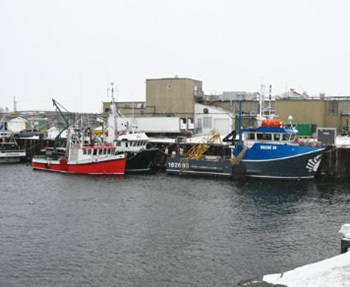 A few days before the start of the fishing season, the oldest shrimp processing plant in Quebec closes its doors. The Danish company Royal Greenland announced on Monday that it was closing down the Eastern Seafood processing plant. The mayor of Matane, Eddy Métivier, speaks of “a total surprise” as the Danish company had recently invested millions to add lobster and crab processing to its activities, in addition to building 71 housing units for its temporary workers. “We are in shock, it’s really a hard blow,” he said in an interview. It is a symbol for Matane. It’s like putting an end to historical fishing traditions. In this sense, too, it is a mourning. more, >>clicck to read<< 14:29
A few days before the start of the fishing season, the oldest shrimp processing plant in Quebec closes its doors. The Danish company Royal Greenland announced on Monday that it was closing down the Eastern Seafood processing plant. The mayor of Matane, Eddy Métivier, speaks of “a total surprise” as the Danish company had recently invested millions to add lobster and crab processing to its activities, in addition to building 71 housing units for its temporary workers. “We are in shock, it’s really a hard blow,” he said in an interview. It is a symbol for Matane. It’s like putting an end to historical fishing traditions. In this sense, too, it is a mourning. more, >>clicck to read<< 14:29
Warming waters send Gaspé’s northern shrimp stock plummeting, spelling trouble for Quebec fishermen
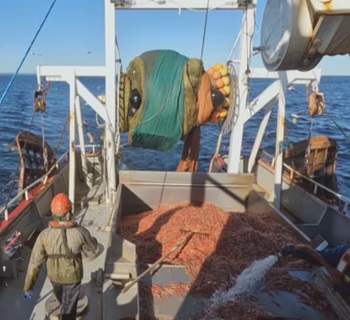 Every year, Fourchette Bleue, which promotes what it calls “under-exploited” marine species in the St. Lawrence for consumption, releases a list of recommended sustainable seafood products for consumers. Toad crabs, oysters and green sea urchins all made the cut this year, but for the first time, the northern shrimp did not. That’s because stocks of the shrimp have taken a major dive in recent years, causing concern in the local fishing industry as Fisheries and Oceans Canada (DFO) floats the idea of potentially closing fisheries in the near future. more, >>click to read<< 07:28
Every year, Fourchette Bleue, which promotes what it calls “under-exploited” marine species in the St. Lawrence for consumption, releases a list of recommended sustainable seafood products for consumers. Toad crabs, oysters and green sea urchins all made the cut this year, but for the first time, the northern shrimp did not. That’s because stocks of the shrimp have taken a major dive in recent years, causing concern in the local fishing industry as Fisheries and Oceans Canada (DFO) floats the idea of potentially closing fisheries in the near future. more, >>click to read<< 07:28
Scotian Shelf shrimp fishery braces for another cut
 For a third straight year, the shrimp fishery off eastern Nova Scotia is facing a big quota cut with ocean conditions to blame. The recent scientific assessment for northern shrimp on the eastern Scotian Shelf showed environmental factors — including warmer ocean water due to climate change — are contributing to the poor condition of the stock, he says. And the response, he predicts, will be a reduction in the total allowable catch. The Department of Fisheries and Oceans (DFO) is expected to announce the 2024 shrimp quota in several weeks. more, >>click to read<< 10:59
For a third straight year, the shrimp fishery off eastern Nova Scotia is facing a big quota cut with ocean conditions to blame. The recent scientific assessment for northern shrimp on the eastern Scotian Shelf showed environmental factors — including warmer ocean water due to climate change — are contributing to the poor condition of the stock, he says. And the response, he predicts, will be a reduction in the total allowable catch. The Department of Fisheries and Oceans (DFO) is expected to announce the 2024 shrimp quota in several weeks. more, >>click to read<< 10:59

Northern Shrimp fishing: DFO proposals do not pass muster in the industry
Northern shrimp fishermen from Quebec and the Atlantic wholeheartedly reject the new precautionary approach presented by Fisheries and Oceans Canada (DFO) scientists to protect stocks. The fishing associations of Quebec, New Brunswick and Newfoundland and Labrador, industrialists and DFO scientists were gathered during two days for the advisory committee which ended Wednesday in Quebec. Northern shrimp stocks in the Estuary and Gulf of St. Lawrence are not likely to improve, according to Fisheries and Oceans Canada. >>click to read<< 11:47
Shrimp fishing: gloomy outlook and angry fishermen
 The state of northern shrimp stocks in the estuary and Gulf of St. Lawrence will not improve in the short and medium term and could even continue to deteriorate. It is this grim observation that Fisheries and Oceans Canada shared with the fishermen and processors gathered Tuesday in Quebec for the first day of the shrimp advisory committee of the Estuary and Gulf of Saint -Laurent. DFO biologists have clearly identified redfish predation as one of the main causes of the decline of shrimp stocks in the four fishing areas of the Estuary and Gulf. The warming of the water in the Gulf and the significant drop in oxygen levels also explain the drastic fall in northern shrimp stocks.>>click to read<<14:12
The state of northern shrimp stocks in the estuary and Gulf of St. Lawrence will not improve in the short and medium term and could even continue to deteriorate. It is this grim observation that Fisheries and Oceans Canada shared with the fishermen and processors gathered Tuesday in Quebec for the first day of the shrimp advisory committee of the Estuary and Gulf of Saint -Laurent. DFO biologists have clearly identified redfish predation as one of the main causes of the decline of shrimp stocks in the four fishing areas of the Estuary and Gulf. The warming of the water in the Gulf and the significant drop in oxygen levels also explain the drastic fall in northern shrimp stocks.>>click to read<<14:12

SEA-NL demands province order ‘serious,’ sweeping review of fish-price setting system
Seaward Enterprises Association of Newfoundland and Labrador (SEA-NL) demands the provincial government order a “serious” and sweeping investigation into the broken fish price-setting system after last year’s token review failed to fix it. “This province’s three largest commercial fisheries — snow crab, northern shrimp, and lobster — are all in chaos this season, and two of them for the second year in a row,” says Ryan Cleary, SEA-NL’s Executive Director. “It’s obvious that last year’s lightning fast, three-month review of the price-setting system — a review that didn’t even bother to consult with inshore enterprise owners — was a token attempt at reform by a government unwilling and unprepared to act.” >click to read< 20:09
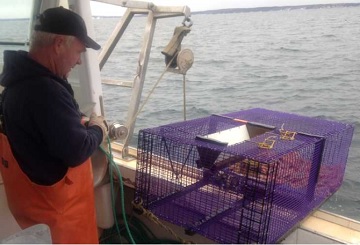
Northern shrimp fishery faces potential permanent closure
Regulators are considering a permanent closure of the northern shrimp fishery off the coast of Maine and New Hampshire. The Atlantic States Marine Fisheries Commission’s Northern Shrimp Section met in Portland last week to discuss several issues related to the northern shrimp. There has not been a northern shrimp fishing season in the Gulf of Maine since 2013. A moratorium was placed on the fishery because the shrimp population collapsed. >click to read< 07:37
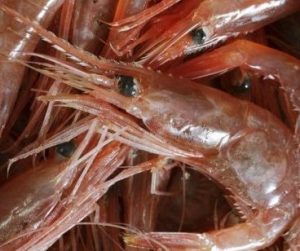
Panel Decision Opposite of Strong Market Indicators, Harvesters Outraged
Shrimp harvesters across the province are outraged by the result of the Standing Fish Price Setting Panel’s decision to set the minimum price for summer shrimp at just $0.90/lb. The decision to side with ASP’s final offer is entirely unsupported by market realities, which show distinct market improvements in recent months. “The Panel’s decision yesterday is incomprehensible. Taking into consideration the significant increase in operational costs, particularly for fuel, fish harvesters will not come close to breaking even at this insultingly low price,” says FFAW-Unifor Sullivan President Keith Sullivan. “The Panel has absolutely not justified themselves in selecting this price,” he says. >click to read press release< 19:06

How warming ocean temperatures wiped out Maine’s shrimp industry
Since 2014 fishing for northern shrimp has been banned in the United States. The stock in our area has decreased to the point where they are not reproducing. This is not due to overfishing; it is directly due to the temperature of the water. They have simply moved north to colder Canadian waters. Back in 2007, when there was a robust northern shrimp fishery in the Gulf of Maine, scientists were looking for net modifications that would catch shrimp but not have any bycatch of finfish. Since shrimp fisheries throughout the world have some of the highest bycatch of any fishery, this was a priority worldwide. At that time the Northeast Consortium at the University of New Hampshire helped fund research by Dr. Pingguo. He and David Goethel developed a trawl net, named “The Topless Trawl,” that drastically reduced bycatch in the northern shrimp fishery. >click to read< 10:21
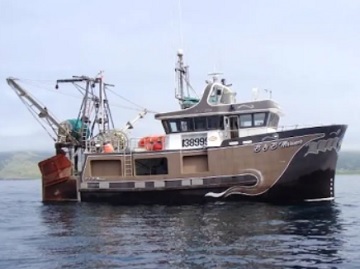
Slashed shrimp quotas cause worries for Newfoundland and Labrador captains
A couple weeks ago Brad Genge made a million-dollar bet on the future of shrimp. He bought another shrimp licence. Now he can only hope it pays off. Genge has been fishing out of Flower’s Cove, a community on Newfoundland’s Great Northern Peninsula, with his father Ren for about three decades. This is the 16th season for their longliner, B and B Mariner. And when another captain decided to retire and sell his enterprise, Genge saw it 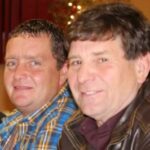 as a chance to grow his own. These days the only way to get more shrimp quota is to buy it from someone willing to sell. Genge has invested heavily to secure three shrimp quotas in the Gulf, in an area near Port aux Choix, and four in the northern zone, off St. Anthony. It comes with risk, considering the shrimp biomass and the quotas have been declining. >click to read< 15:15
as a chance to grow his own. These days the only way to get more shrimp quota is to buy it from someone willing to sell. Genge has invested heavily to secure three shrimp quotas in the Gulf, in an area near Port aux Choix, and four in the northern zone, off St. Anthony. It comes with risk, considering the shrimp biomass and the quotas have been declining. >click to read< 15:15

Minister Ignores Established Precautionary Approach for Shrimp – Slashes Quotas in Struggling Fishery
Minister Joyce Murray’s decision today to slash quotas in the Gulf of St. Lawrence shrimp fishery is a significant blow for harvesters and plant workers who have already experienced drastic cuts over the last number of years. A cut of nearly 20 per cent in Shrimp Fishing Area (SFA) 8 in the Gulf of St. Lawrence is contrary to the recently established Precautionary Approach (PA), showing Minister Murray’s lack of commitment to collaborative fisheries management. >click to read< 08:58

Northern Shrimp Assessment Fails to Capture True Picture of Stock Health
The Department of Fisheries and Oceans (DFO) science department delivered a technical briefing to industry this morning detailing the most recent stock assessment for northern shrimp. FFAW-Unifor continues to call on the Department to reassess the Limit Reference Point (LRP) for northern shrimp and incorporate harvesters’ observations in science assessments. “The LRP is set at a time when cod and other groundfish were at very low levels. Expecting the species to rebound to that level when the marine environment is now completely different is short-sighted. We need to consider the entire marine ecosystem when establishing rebuilding plans,” says FFAW-Unifor President Keith Sullivan. >click to read< 18:27

DFO to Release Latest Assessment of Northern Shrimp Stocks
DFO will provide an update this morning on its latest assessment of northern shrimp stocks in the waters surrounding Newfoundland and Labrador and the FFAW will be watching very closely Fisheries Union President Keith Sullivan says they’ll be interested in seeing whether the information and concerns provided by harvesters, particularly as it relates to the Sustainable Fisheries Framework are reflected in today’s announcement. >click to read< 10:27

Gulf of Maine: Shrimp fishery to remain closed for three more years
For the eighth straight year, Maine’s commercial shrimp fishery will remain closed to harvesters. The Atlantic State Marine Fisheries Commission’s Northern Shrimp Section voted last week to keep the fishery shut down for at least three more years citing an assessment update that indicated the stock in the Gulf of Maine remains depleted. A commercial fishing moratorium has been in place since the 2014 season,,, >click to read< 08:30

Shrimp prices set for Nfld. and Labrador, stockpiles and restaurant closures reducing shrimp demand in U.K.
A dollar a pound was not enough to lure the inshore shrimp fishing fleet in Newfoundland and Labrador to set their gear this spring. But most boats are hitting the water now, as the crucial summer shrimp fishing season opens. This week saw the price increase by 10 cents, to $1.10 a pound, for summer catches following a ruling by the province’s Fish Price Setting Panel. The U.K. and Europe are the main markets for shrimp exports from this province. >click to read< 13:54

Will fishing shrimp be worth it this year?
The price set by the Association of Seafood Producers came in at one dollar a pound Thursday, with the Fish, Food and Allied Workers Union pushing for a price of $1.50. Shrimp harvester Rendell Genge has been in the industry since 1970, and has seen up and down years fishing on the west coast of Newfoundland. This summer, he wonders if taking his boat out will be feasible. “There’s no way we can fish for a dollar,”,,, “We had a group meeting and 100 per cent agreed not to go fishing [unless] we do the $1.50, at least $1.50 right now.” >click to read< 19:46

Newfoundland shrimp fishermen still in limbo as fish plants remain idle
Normally, the shrimp fishing season starts by June, with fishers in this area wrapping up their season in late August and hoping not to have to fish through the bad weather months of mid to late fall. But a wrangle over shrimp prices has lasted longer than usual, thanks in part to the uncertain markets caused by Coronavirus. In mid June the province’s Price Setting Panel decided on a price of $1.18 per pound, choosing the price suggested by the Fish Food and Allied Workers (FFAW-Unifor) over the price of .70 cents per pound suggested by the Association of Seafood Processors (ASP). Meanwhile, according to the union, shrimp processors in New Brunswick and Quebec, including a Royal Greenland-owned plant, have been buying shrimp from harvesters in that province while refusing to purchase from Newfoundland and Labrador harvesters. >click to read< 07:37

2020 shrimp price disagreement for NL fish harvesters goes to arbitration
There’s 58 cents worth of disagreement over shrimp prices between the union that represents fish harvesters and the organization that represents processors in Newfoundland and Labrador. According to the union, the Association of Seafood Processors (ASP) proposed 70 cents per pound while the FFAW proposed $1.18. The matter is now before the Standing Fish Price Setting Panel, which met today in St. John’s to hear the proposals from both sides.,, The union also said, “This is a challenging year for shrimp, as the market is lower than it was last year.” However, the union also said the 70 cent offer from the ASP “is a price that cannot be justified by any rational assessment of the market.” >click to read< 16:07
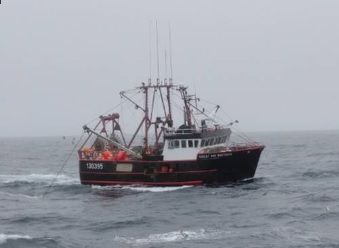
Possible quota reduction on Northern Shrimp concerns Newfoundland fishers and communities
This could mean hard times in an already hard businesses, harvester Chris Rose told the Northern Pen. He is hoping to make enough this season to pay the bills. The St. Carol’s fisherman owns his own boat, with a four-member crew, and has been fishing since 1991.“Two years prior to last year I had to give my crew some of my boat’s percentage so they could get enough to qualify for EI,” Rose said. “We are down to crunching numbers that fine.” He said when he started in 1999 shrimp fishing was great, then it exploded between 2008 to 2014. It has been going steadily downhill since.“Since the peak I’ve lost 80 percent of my shrimp quota,,, >click to read< 08:42

Northern Shrimp Harvester Roland Genge questions science methodology, hoping for changes to quota rules
He’s seen the best the Newfoundland and Labrador fishery has had to offer over the past 42 years — and the worst. From buying a new boat in the 1980s, to the collapse of cod in 1992, to the rise of shrimp quotas and price, Roland Genge has taken the waves of the inshore fishery in stride. Now, the Anchor Point fisherman is concerned about last month’s shrimp assessments. “We’re going to be cut … every year on account of the way the survey is being done,” >click to read< 08:14

Cautious, healthy and critical. Northern shrimp stocks a mixed bag, suggest DFO’s latest numbers
Shrimp in fishing areas 4, 5, and 6 are assessed by the Department of Fisheries and Oceans every February. On Monday, the agency said despite some uptick, “We continue to be concerned about the future of these stocks.” For shrimp fishing Area 4, the stock remains in the cautious zone. For shrimp fishing Area 5, the stock is in the healthy zone. For shrimp fishing Area 6, the stock remains in the critical zone, according to DFO’s briefing. DFO said there are several factors that could account for Area 6 retaining critical status, including above-average bottom temperatures, and more predators. >click to read< 15:31
VIDEO: DFO northern shrimp stock assessment for N.L. far from rosy – >click to read<
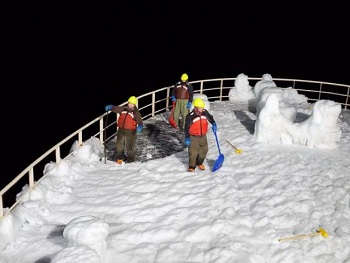
Captain Titus: Canadian fisherman’s Twitter tweets a rare glimpse of a hard life in the North Atlantic
From the outset, the captain’s social media strategy has been to post photos and see what happens. What has happened, in the eight years since his first tweet, is a master Canadian mariner has offered a rare, real-time glimpse into what life is like, say, in the dead of winter on a boat in mountainous seas several hundred kilometres off the coast of Labrador. Or what it is like to be bumping through the ice between Baffin Island and Greenland aboard the Mersey Phoenix, a 70-metre vessel with 30 crew and a quarry, Pandalus borealis/ photos, >click to read< visit https://twitter.com/shrimpfisherman 08:05

Northern Shrimp: Future not promising for shrimp fishery
The fate of the shrimp fishery for the coming year, if any, will likely be determined Friday afternoon when the Northern Shrimp Section of the Atlantic States Marine Fisheries Commission meets to review the 2019 Stock Assessment Update Report and updates from the section’s Summer Survey Work Group and the Northern Shrimp 2019 Summer Survey Results. The meeting will be held by telephone and interested parties may listen to the proceedings by joining in the conference call or by signing in to a “webinar” on the internet. >click to read< 09:29
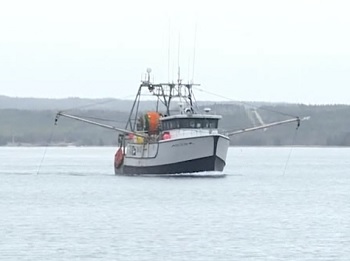
Fishermen say price is right this year for northern shrimp and lobster
Shrimp and lobster prices have plummeted in recent years, but what about this season? Fishermen say the price is right. Video, >click to watch<13:25

Northern shrimp stock plunges off the coast of Labrador
The federal Department of Fisheries and Oceans’ latest northern shrimp assessment shows a dramatic drop in the offshore Labrador stock, with a slight increase for the inshore fishery in Newfoundland. New data from DFO Monday reveal a 46 per cent drop in the fishable biomass — defined as the weight of all the shrimp larger than 17 millimetres — between 2017 and 2018 in Shrimp Fishing Area 4, along Labrador’s northernmost coast, to 42,100 tonnes. Heading south down Labrador’s coast to Shrimp Fishing Area 5, the biomass has dropped 43 per cent, to 80,100 tonnes. >click to read<
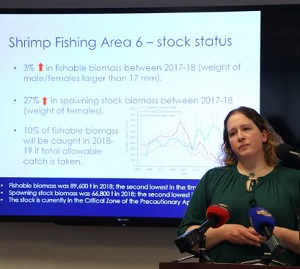
Small shrimp biomass increase off Newfoundland’s northeast coast
The latest news about the state of the northern shrimp stock in key Shrimp Fishing Area 6 off the province’s northeast coast is a bit more uplifting this year than about the same time last year. Last year the news was grim — this year, although the shrimp stock remains listed in the critical zone, the fishable biomass has increased by three per cent between 2017 and 2018, and there’s a 27 per cent increase in spawning stock biomass between 2017 and 2018. >click to read<19:33


































